John Smith
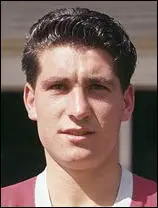
John Smith was born in Shoreditch, London on 4th January, 1939. He was discovered by Wally St. Pier as a schoolboy while playing for Eton Manor, a club established for the he youth of the East End of London. He joined the West Ham United groundstaff in 1954 and signed as a professional in January, 1955. (1)
Ted Fenton had become manager in 1950 with the intention of providing entertaining, winning football: "The only way to build the club was youth. There were lots of good players around, but I had no money to buy the key players we needed." Fenton and St. Pier, began to attend as many local matches as possible and did everything to ingratiate themselves with schoolmasters and football officials. Charles Korr has pointed out: "They emphasized that things had changed at West Ham and that the club was once again really interested in local players. The men who ran West Ham might have been guilty of taking their fans for granted for years but were even more culpable in not cultivating the community as the natural area from which they could attract young players." (2)
Smith joined a youth team that over the next few years included Andy Malcolm (joined 1950), Harry Hooper (1950), John Bond (1950), Bobby Moore (1950), George Wright (1951), Ken Brown (1953), Andy Nelson (1953), Malcolm Pyke (1953), Malcolm Musgrove (1953), John Lyle (1955), John Cartwright (1956), Joe Kirkup (1955), Brian Dear (1958), Bill Lansdowne (1956), Geoff Hurst (1956), Andy Smillie (1956), Brian Rhodes (1957), Tony Scott (1957), Jack Burkett (1958), Eddie Bovington (1958), Harry Cripps (1958), Ronnie Boyce (1959), Martin Peters (1959), Dave Bickles (1960), Trevor Dawkins (1960), John Sissons (1961), Peter Bennett (1961), Martin Britt (1961), John Charles (1962), Harry Redknapp (1962), Bill Kitchener (1963) and Bobby Howe (1963).
Malcolm Allison was the captain at the time and had been asked by Ted Fenton, the club manager, to coach the young players like John Smith. Allison later recalled: "Fenton used to pay me £3 extra for training the schoolboys at night. It was then that I found I had a bit of a gift for spotting the boys most likely to make it as professionals." (3) It has been argued that Allison and Fenton developed the idea of the "West Ham academy of soccer". If the headmaster was Fenton, the school was being run by Allison, the "head boy". As one historian has pointed out: "Allison got his opportunity because a new generation of players was coming through, who were willing to listen to almost anything that might lead to success. He could convince other players how badly he wanted success for them, as well as for himself. His confidence and enthusiasm were contagious." (4)
John Cartwright later recalled: Malcolm Allison generated ideas. He was like a father to me. West Ham would never have got Moore and Hurst without Malcolm Allison. The coaching was originated by Malcolm, he started the Academy. (5) Cartwright argued that the "players really ruled it... it was a form of communism". (6) Allison admitted: "We were like any revolutionary group. We got excited and built up a good feeling." (7)
Debut of John Smith
Allison was impressed with Smith and managed to persuade Fenton to play him in the first-team when he was only 17 years-old. Fenton told The Daily Mirror and the morning of his debut against Port Vale on 15th September, 1956. "An ordinary name but no ordinary player. He has an old head on young shoulders and the right temperament." The newspaper added: "Smith, a stockily-built youngster from Bethnal Green, East London, is certain of one thing - he will be able to last the pace. Since he signed pro-forms last January he has been first man home on West Ham's long distance training trots." (8)
Smith replaced the veteran Albert Foan in the inside-right position. He kept his place and when Frank O'Farrell got injured he moved to wing-half. By the end of the season he had scored four goals in 29 games. (9) Smith got "rave reviews" for his performances. (10) The football journalist, Jeff Powell, commented that "Smith was the white hope of West Ham". (11)
The fans had seen Smith as a replacement for the very popular Harry Hooper who had scored 15 goals in 30 league games in the 1955-56 season. Several clubs in the First Division tried to buy Hooper. However, he was eventually bought by Stan Cullis, the manager of Wolverhampton Wanderers, for the club record fee of £25,000. Cullis wanted him as a replacement for former England star, Johnny Hancocks. commented that: "Like Hancocks, Hooper was fast, direct, able to play on either wing and was both accurate and powerful in his use of the ball with either foot. In short, he was an ideal winger." (12)
Hooper was West Ham best young player and had been at the club since he was 17-year-old and refuelled arguments that the club lacked ambition: "The truth is I never wanted to leave West Ham. I explained to Ted Fenton that I didn't want to go but he said there was nothing he could do - the club needed the money because the school in Castle Street wanted their land back, which was then serving as the main entrance to the ground on Green Street. The money received from Wolves paid for the current main entrance which was completed in 1958." (13)
Malcolm Allison
Malcolm Allison took over the control of first-team training sessions in 1957. Looking back to the start of his training activities at Upton Park, he recalled: "I took charge of the coaching at West Ham. I built the attitude. We used to get together and I used to make them come back for training in the afternoons." Allison also began picking the team. Mike Grice commented: "Three team sheets would go up for match days. Malcolm would look at them all, take them down and go and see Ted. When they went up again they had invariably changed." Bill Lansdowne recalled: "Fenton would give us a chat and on the way out of the dressing-room Malcolm would say what to do." (14)
Allison admitted that it was an example of player power: "My relationship with the West Ham manager Ted Fenton was much closer than the one I had had with Jimmy Seed (his manager at Charlton). But it was scarcely satisfactory. I did give him some problems, but they arose chiefly out of my frustration with the way the club was run. And eventually I began to run the team, with his tacit agreement. He could see that I was getting results. Player power is a phrase which has become fashionable in modern football. But it was being practiced in the West Ham dressing room 20 years ago. I began to draw up my own training schedules, and people like Phil Woosnam, Noel Cantwell, John Bond and Frank O'Farrell came in with me." (15)
Eddie Lewis who joined West Ham in 1956 after spells at Manchester United and Preston, had been used to training that consisted of little more than laps of the pitch followed by 15-a-side free-for-alls. "Under Malcolm everything was so organised. One small group would be playing six versus six, another playing head tennis, another doing weights, another running. The whistle would blow and the groups would change. You didn't see any clubs doing that at that time." (16)
Promoted to the First Division
John Smith and remained in the first team for the 1957-1958 season. West Ham had been in the Second Division since the end of the 1931-1932 season. They began in an unremarkable fashion. By mid-October they only had 12 points from 12 matches. Ted Fenton, felt he needed a new striker and decided that he wanted Vic Keeble who was playing at Newcastle United. He had managed him at Colchester United, and considered him a great finisher. He telephoned Keeble and said: "I'm coming up Saturday, I fancy you Vic, I could well put in a bid for you. I'll take a look at you, see how you do." Keeble scored two goals in the first 45 minutes and at half-time Fenton knocked on the window of the dressing-room and said: "Vic, don't play too well in the second-half, they won't let you go." After the game Fenton bought Keeble for £10,000. (17)
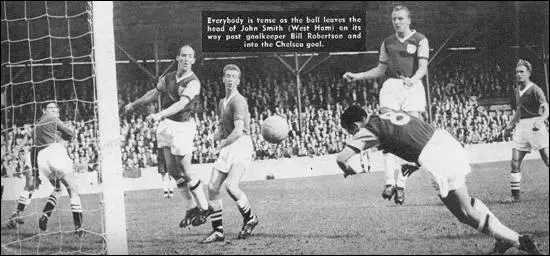
Vic Keeble had been a West Ham fan when he was a boy and so he welcomed a move to the club. (18) Eddie Lewis, who was replaced in the side by Keeble was not impressed by the signing. "After I was dropped I scored four goals in a reserve game... Ted Fenton was obsessed with Vic Keeble, so I just didn't get any games. Ted wasn't the sort of bloke you could talk to about anything." Other players also had their doubts. Mike Grice complained: "Feeble Keeble, the legless wonder... But he was great in the air." Ken Brown added: "Vic Keeble couldn't kick a ball ten yards, but he could head a ball." (19)
Keeble was a great success at West Ham United: "I partnered John Dick and we clicked instantly, scoring 40 goals between us. I was really enjoying my football and grabbed a hat-trick in a 5-0 win against Stoke City, two in 6-1 wins over Lincoln and Bristol Rovers, and further braces in a 6-2 victory over Swansea and 8-0 thumping of Rotherham United. The Hammers clinched the title in the final game at Middlesbrough, where we won 3-1. I knocked in the third goal." (20)
Keeble scored 19 goals that season. Johnny Dick was top scorer with 21 goals and Billy Dare contributed 14. All three men benefited from the service provided by John Smith, who also hit the net 11 times. West Ham was a devastating attacking team scoring a record total of 101 goals that enabled them to win the league championship. After 26 seasons in the second division West Ham was promoted to the top tier. (21)
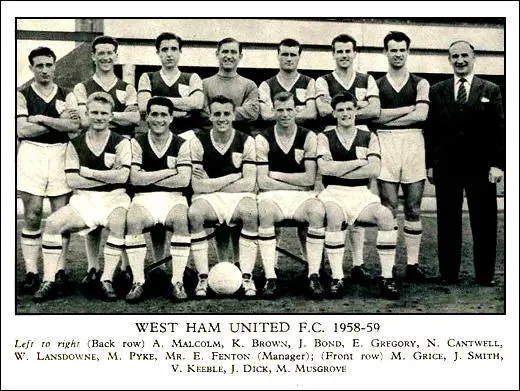
Vic Keeble was full of praise for John Smith who was seen as the creative general of the team: "He needed to be encouraged to get hold of the ball. He was a good, fit lad, though, who really enjoyed training." Keeble's main friend was Johnny Dick: "Johnny and I were a bit inseparable - we loved dog racing. After training on Tuesdays we'd catch the last two races at Dagenham or Hackney Wick. I liked going to Walthamstow, where he knew one or two of the greyhound trainers... Johnny Smith was a bit of a loner in some ways. I think he liked to gamble but he never came out with us." (22)
West Ham United made a very good start to the 1958-1959 season. As the newcomers to the First Division they took the other teams by surprise. They won their first three games against Portsmouth (2-1), Wolverhampton Wanderers (2-0) and Aston Villa (7-2). This was followed by a draw and a defeat. However, when they played Manchester United on 8th September, 1958, they knew that a victory would take them to the top of the league. (23)
Sam Leitch reported what happened in The Daily Herald the next morning: "What a cheek which was contemptuous West Ham toyed with Manchester United last night and built up a load of three cracker-jack goals in 60 minutes. Then their strolling, lazy genius got them into trouble as United... slammed back. Had the game lasted another ten minutes I think the Busby Babes would have collected a point. Still over confidence or not, the East End boys of London are top of the First Division this morning - after another joy infested night at this tight little London stadium. The permanently demoralised in the first-half of the slick deadlines and inter-changing of the West Ham inside men, Vic Keeble, John Smith and John Dick... Ron Cope and Goodwin tangled repeatedly as they were jolted out of their stride by the crossfield genius of Malcolm, the punch of Musgrove and the gentle, yet deadly, tip-tapping of Keeble and Smith. It was a magic, high-speed move in the 38th minute which scissored that defence again. From Keeble to Dick, for the big Scot to roll it only a yard forward for Smith to blast home from 18 yards." (24)
In November, 1958, Ted Fenton paid £10,000 for Welsh international inside-right Phil Woosnam. This surprised the West Ham fans as John Smith had played in this position for the last couple of seasons. As one journalist pointed out: "For some reason, not altogether explained, the West Ham management had harboured doubts about the inside right position even though its occupant, young Johnny Smith, had won many plaudits for his fine play and was particularly well thought of because he'd come up through the ranks and was a shining example of West Ham's much vaunted youth policy." (25)
After playing the first fifteen games of the season at inside-right, Smith was replaced by Woosnam. After missing six games Smith was moved to left-half where he remained for the rest of the season. West Ham did very well in their first season in the top tier finishing in sixth place. Smith played in 36 of the 42 games and helped Dick (27) and Keeble (20) to score 47 goals between them. Now he had shown he was also an effective footballer in the First Division he was awarded an England under-23 cap against France in November 1959. He was considered one of best young players in the country and was called up into the England squad but he did not play. (26)
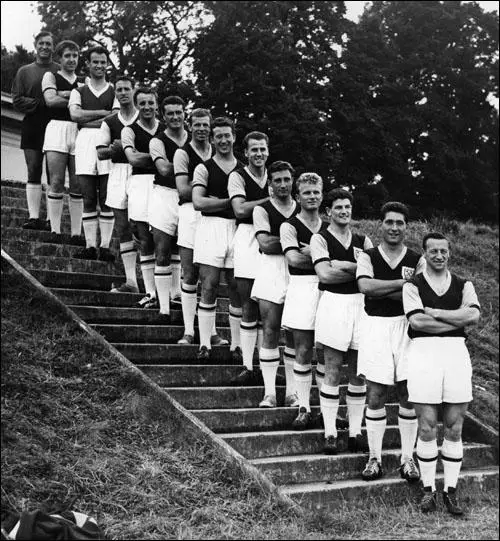
Malcolm Pyke, Andy Nelson, Vic Keeble, Noel Cantwell, Johnny Dick, Ken Brown,
Andy Malcolm, Mike Grice, Bill Lansdowne, Malcolm Musgrove, John Smith and Billy Dare (1958)
The "West Ham Academy" had proven very successful and the youth team reached the 1959 FA Youth Cup Final. Although he was only 20, John Smith, because he was a first-team regular, did not appear in the West Ham team. Youngsters who did play included Bobby Moore, Geoff Hurst, Harry Cripps, Jack Burkett, Eddie Bovington, Andy Smillie, John Cartwright, Derek Woodley, Mick Beesley and Tony Scott. Unfortunately, after drawing at home 1-1, they lost the return 1-0. This team included seven youth internationals and nine players that later played in the first team. (27)
Smith's good form continued in the 1959-1960 season. For a twenty-year old his consistency was impressive. On the couple of occasions when he was injured he was replaced by Bobby Moore or Geoff Hurst, who were both two-years younger than Smith. In his autobiography Hurst complained that he doubted his ability to get a regular place in the first-team because of the quality of Smith and other midfielders such as Moore, Andy Malcolm, Eddie Bovington and Bill Lansdowne. He was also concerned with "a tall, thin lad from Plaistow called Martin Peters who was gradually working his way up through the ranks." (28)
Transferred to Tottenham Hotspur
On 15th October, 1959, Vic Keeble got injured. West Ham lost five of the next right games. Keeble returned for the game against Leeds United but was injured again and it was followed by another poor run of results. Dick's goals also dried up without the presence of Keeble. Ted Fenton decided that he needed to find another centre-forward. His choice was David Dunmore of Spurs. He was in the reserves and could not get a game and Bill Nicholson, the Tottenham Hotspur manager, told Fenton he could have him in exchange for John Smith. Nicholson wanted Smith as he was a versatile player who could provide cover for Danny Blanchflower, Dave Mackay, John White and Les Allen. (29)
Smith played his last game for West Ham on 12th March, 1960, against Blackpool. It was a memorable one because he had to take over in goal when Brian Rhodes was injured. (30) The transfer deal became public four days later. One journalist pointed out that the deal made more sense for West Ham than Smith: "John Smith the West Ham United and under-23 international, and David Dunmore, the Tottenham forward, changed clubs in a straight transfer. No cash was received. Dunmore will be at centre-forward in the West Ham team to receive Blackburn Rovers on Saturday. West Ham have been without an effective leader of their attack since Keeble was injured earlier in the season. It is not so easy to see where Smith can be fitted into the Spurs team immediately. Smith plays at inside forward and wing half-back positions adequately filled at White Hart Lane at the moment." (31)
John Smith joined Tottenham at a time when they were top of the First Division and only managed to make one appearance in the 1960-1961 season. This must have been very upsetting for Smith as the club became the first team in the 20th century to win the league and cup double. Bob Goodwin, the club historian, claims that it was "the greatest team in Spurs history" and unfortunately "the great strength of the team lay in midfield where Danny Blanchflower, Dave Mackay and John White strutted their stuff." (32)
1969 League Cup Victory
Smith made five appearances in the 1961-1962 season and seven games (one goal) in the 1962-63 season. The following season he was transferred to the Second Division side, Coventry City, where he became a first-team regular. However, he was not happy living outside London and in 1965 moved to Leyton Orient. After 39 games and 3 goals he was on the move again and in 1966 he joined Torquay United that had just been promoted into the 3rd Division. Managed by Frank O'Farrell, a former West Ham player, who also recruited John Bond and Ken Brown. At the end of their 1966–67 campaign United finished in seventh, and at the end of their 1967–68 season, United came very close to promotion to Division Two, once again. O'Farrell left to manage First Division Leicester City in 1968 and Smith also left the club at the same time. (33)
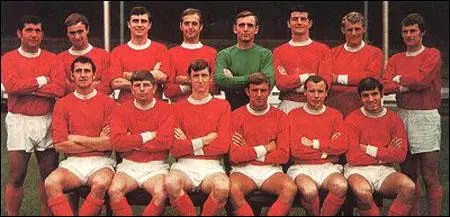
Swindon Town in the Third Division paid £7,000 for Smith, which in many ways was the most rewarding of his career where he was a member of the team that beat Arsenal in the 1969 FA League Cup medal. Wearing the number nine shirt, he was the creative midfield general and the key figure in the victorious League Cup campaign, playing in all 12 games and scoring 3 goals (two in the semi-finals against Burnley). Alan Hoby reported that "Swindon those little Third Division wonders from Wiltshire, yesterday won the League Cup before 100,000 bewitched spectators when they destroyed the lordly Arsenal from the First Division.... Arsenal, slaves of their own system, methodical but utterly predictable, were finally unhinged by the individual brilliance and flair of the Swindon stars - the small town Cinderellas whom cynics expected to lose to the North London favourites by a bucketful of goals." (34)
In June 1971 Smith moved to Walsall. A year later he was appointed club manager, but resigned in March 1973. Soon afterwards he became player manager of Dundalk in the League of Ireland He recruited virtually a new squad with a strong sprinkling of ex-English League players including Jimmy Dainty, Dougie Devlin, and Willie Penman. Despite an excellent season start - 11 wins from the first 14 games - the bubble burst before Christmas and finished in sixth place finish in the League. After a poor start to the next season Smith was sacked. (35)
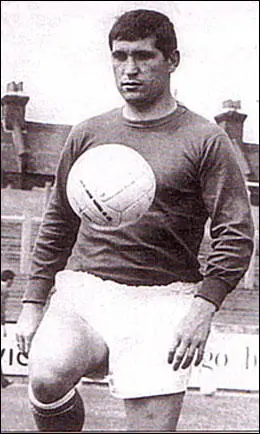
John Smith drifted out of football and became the manager of McVitie's social club in Harlesden and died of a heart-attack, aged 49, in February, 1988.
Primary Sources
(1) The Daily Mirror (15th September, 1956)
West Ham confidently introduced a seventeen-year-old new boy in league football at Port Vale this afternoon - inside forward John Smith.
"An ordinary name but no ordinary player" is manager Ted Fenton's summing up. "He has an old head on young shoulders and the right temperament."
Smith, a stockily-built youngster from Bethnal Green, East London, is certain of one thing - he will be able to last the pace.
Since he signed pro-forms last January he has been first man home on We3st Ham's long distance training trots.
(2) Sam Leitch, The Daily Herald (9th September, 1958)
What a cheek which was contemptuous West Ham toyed with Manchester United last night and built up a load of three cracker-jack goals in 60 minutes. Then their strolling, lazy genius got them into trouble as United... slammed back. Had the game lasted another ten minutes I think the Busby Babes would have collected a point.
Still over confidence or not, the East End boys of London are top of the First Division this morning - after another joy infested night at this tight little London stadium. The permanently demoralised in the first-half of the slick deadlines and inter-changing of the West Ham inside men, Vic Keeble, John Smith and John Dick...
The prize duel of the night was between that tough little tornado Andy Malcolm emerging as a master right-half of England class, and inside-left Bobby Charlton, who has never been anything but England class...
Back to the non-stop battering which United took right from the start. Panic in the seventh minute by right-half Freddie Goodwin let the burly Dick storm through to lob a high ball over Gregg's head.
Ron Cope and Goodwin tangled repeatedly as they were jolted out of their stride by the crossfield genius of Malcolm, the punch of Musgrove and the gentle, yet deadly, tip-tapping of Keeble and Smith.
It was a magic, high-speed move in the 38th minute which scissored that defence again. From Keeble to Dick, for the big Scot to roll it only a yard forward for Smith to blast home from 18 yards.
On the 60th-minute mark again those leaden0footed United defenders clustered around and could not pounce quick enough to foil Musgrove leaving Gregg helpless from 20 yards.
(3) Kirk Blows and Tony Hogg, The Essential History of West Ham United (2000)
For some reason, not altogether explained, the West Ham management had harboured doubts about the inside right position even though its occupant, young Johnny Smith, had won many plaudits for his fine play and was particularly well thought of because he'd come up through the ranks and was a shining example of West Ham's much vaunted youth policy.
Smith could perform equally as well at right half, however, and with this in mind Ted Fenton swooped to sign Leyton Orient's brilliant Welsh international inside right Phil Woosnam in a 30,000 deal in November 1958 which killed at a stroke any lingering doubts that West Ham lacked ambition and didn't really care about being in the 'big time'. Woosnam had a BA, was a schoolmaster at Leyton County High School, an academic and intellectual and would also become the first truly world-class player West Ham ever bought.
(4) Birmingham Daily Post (16th March, 1960)
John Smith the West Ham United and under-23 international, and David Dunmore, the Tottenham forward, changed clubs in a straight transfer. No cash was received.
Dunmore will be at centre-forward in the West Ham team to receive Blackburn Rovers on Saturday. West Ham have been without an effective leader of their attack since Keeble was injured earlier in the season.
It is not so easy to see where Smith can be fitted into the Spurs team immediately. Smith plays at inside forward and wing half-back positions adequately filled at White Hart Lane at the moment.
(5) Alan Hoby, Sunday Express (16th March, 1969)
Those Swindon those little Third Division wonders from Wiltshire, yesterday won the League Cup before 100,000 bewitched spectators when they destroyed the lordly Arsenal from the First Division. Hero of this murky afternoon, the boy with the winning flair, was £100,000 Don Rogers, who after the Gunners had levelled through Bobby Gould, four minutes from the end, twice scored in extra time.
Arsenal, slaves of their own system, methodical but utterly predictable, were finally unhinged by the individual brilliance and flair of the Swindon stars - the small town Cinderellas whom cynics expected to lose to the North London favourites by a bucketful of goals.
But even though the Wembley pitch was drenched and heavy and sanded in parts like a bull ring, Swindon's spirit, stamina, and skill never faltered. Perhaps they remembered how they had come from behind against Burnley in the semi-finals. But I don't think so.
With stamina running out - Arsenal's Frank McLintock, whose fourth losing Final it was, twice broke down with cramp - it was Swindon who after Gould had headed against a post at the beginning of extra time, stormed irresistibly into the lead again.
First Roger Smart, who like Peter Noble, fully lived up to his name in this titanic struggle, headed with the goal roar rising from the crowd only for Bob Wilson to push the ball onto a post.
The muddy mark on the white paint was scarcely dry when in the last minute of the first half of extra time the Arsenal defence had another attack of jitters from a Swindon corner.
There was a shambles of gold-and-white shirts kicking wildly at the ball before man-of-the-match Rogers coolly cracked it in amid the most tremendous uproar.
This vast fall-out of emotion lit a bonfire in every Swindon man. They ran and ran and ran. They broke clear time and again from the tiring tentacles of the Arsenal rearguard: and, by their courage and refusal even to concede defeat, the Swindon Cinderellas brought a golden glow to this grey day.
